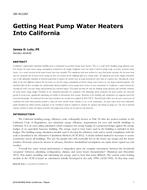Click here to purchase
This paper applies machine learning (ML) algorithms to detect abnormalities in chilled water systems (CWS) at building level. The identification of two abnormal situations are pursued: inaccurate chilled water sensor readings and low thermal efficiency in terms of delta T. The visualization of building chilled water data provides general trends and an initial identification of the building abnormalities; this visualization also helps to lay down the requirements for the abnormality detection algorithms, and eventually, their selection. Abnormal performance is flagged by these algorithms and abnormality indices are assessed with respect to two baselines: normal operation and the best operation found (in terms of ΔT). Two contexts of abnormality detection and quantification are presented. First, historical data is searched for normal and abnormal clusters. The abnormality indices of cluster frequency, thermal efficiency and power loss, all with respect to the normal operation baselines, are calculated. The second context is the abnormality detection of real-time data, where abnormality indices thermal efficiency and power loss assessment are assessed with respect to the best operation found in the normal operation cluster.
Citation: 2016 Winter Conference, Orlando, FL, Conference Papers
Product Details
- Published:
- 2016
- Number of Pages:
- 8
- Units of Measure:
- Dual
- File Size:
- 1 file , 880 KB
- Product Code(s):
- D-OR-16-C079


